What are some of the best things to do in Athens? Welcome to another high-speed dance through one of the world’s most historic cities.
Athens is widely referred to as the cradle of Western civilization and the birthplace of democracy.
It’s an open-air museum unlike any other place in the world. The sheer amount of art, history, and culture located in such a small area is staggering. But where do you start?
You already know of my love for high-speed travel, but with so much to see, where do you even begin? Luckily, if I could show you how to see Rome in three days, then Athens in four is a piece of cake. In fact, three days is probably a bit better for this list. I just happened to have four while I was there.
Here is my list of the best things to do in Athens.
Table of Contents
Greece Travel Restrictions 2022
Before we start, the question that is on the tip of everyone’s tongue… Can you currently travel to Greece?
That’s a Texas size 10-4, good buddy.
Greece is currently open to most vaccinated or certified COVID-free tourists without the need for quarantine.
Visitors must show either proof of full vaccination, completed more than 14 days before arrival, proof of recent COVID recovery, proof of a negative PCR test taken within 72 hours of arrival, or a rapid antigen test taken no more than 24 hours prior to arrival.
Greece is currently coming down hard on unvaccinated visitors, barring them from entering many of the locations that people visit Greece to see, such as museums. exhibition centers, fitness centers, and sports venues. So be sure you carry your proof of vaccination on you at all times.
If you’re unvaccinated, this trip might get a bit inconvenient.
As always, be sure to check the restrictions before you go because they change like the wind.
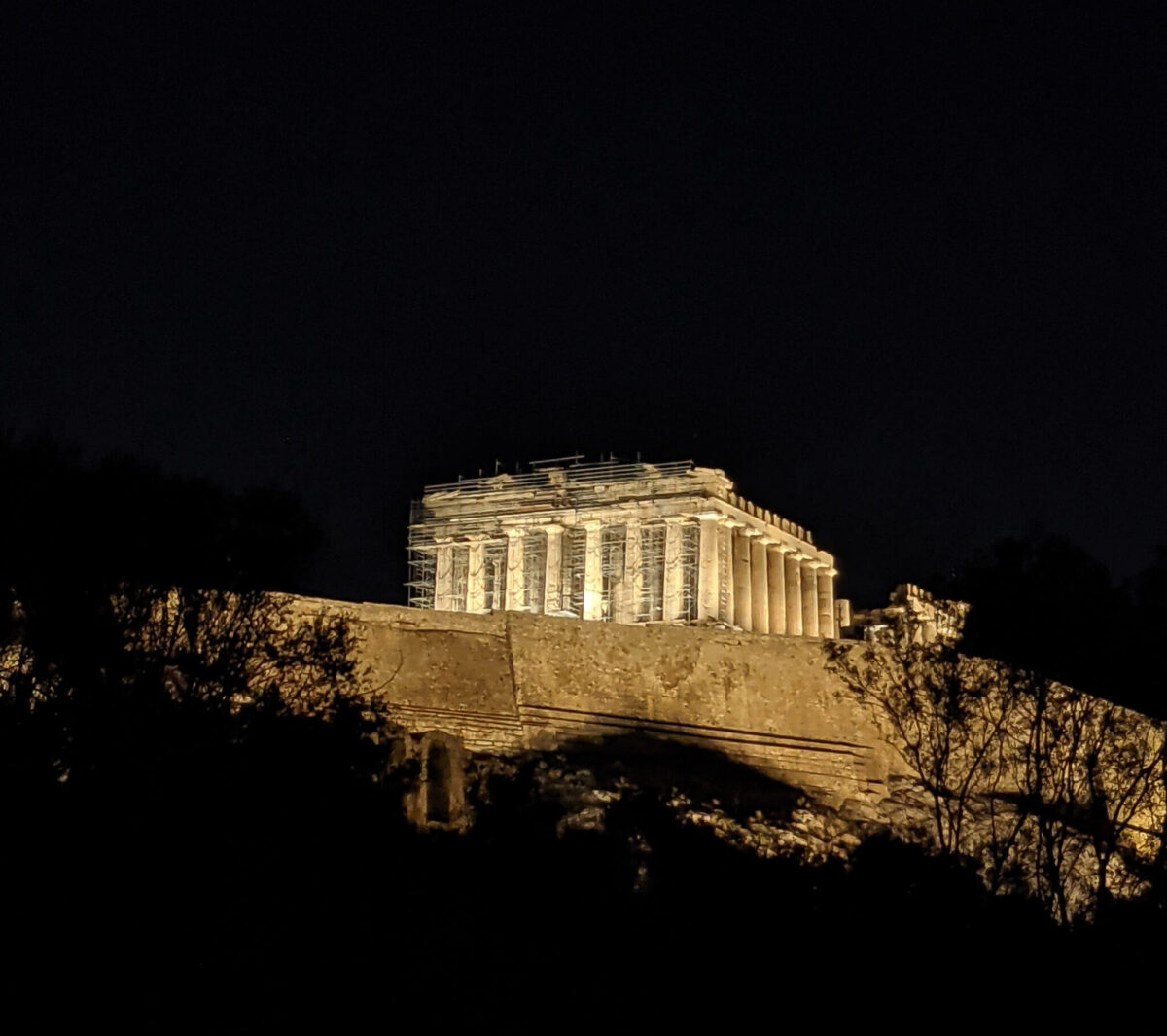
The Lay of the Land!
I assembled this map for your convenience.
I did make an attempt to group things on my list based on proximity, but as you can see, everything is so close and concentrated in the center of Athens that it doesn’t make much of a difference.
While in Athens, I walked everywhere from my hotel with only two exceptions. Those being the National Archaeological Museum, which is the only place I’d consider far from the center, and The First Cemetery of Athens, which just happened to be closed for an event during my first walking attempt. Then, on my second visit, it was getting late in the day, so I needed to hurry and get there before it closed.
I did draw up a map of the best things to do in Athens completely by hand, but I think this Google version looks a bit more professional than highlighter and crayon.
So what’s on the map?
The Acropolis
Every Greek city had an acropolis of its own, but The Acropolis of Athens has grown to be the most famous. It is the classic image that most people associate with Greece. The rocky hill that overlooks the city plays host to some of the most important and best-preserved temples in Athens.
Naturally, this is one of the most popular attractions in Athens, so I would highly recommend purchasing a Skip the Line ticket. With this ticket, you can essentially walk right in without having to wait.
I was in Athens during COVID and the shoulder season, and there was still a really long line for tickets that I was able to skip.
The Athens Acropolis is open every day of the week from 08:00 AM to sunset.
Cost:
- 20€ for adults from April 01 to October 31
- 10€ for adults from November 01 to March 31
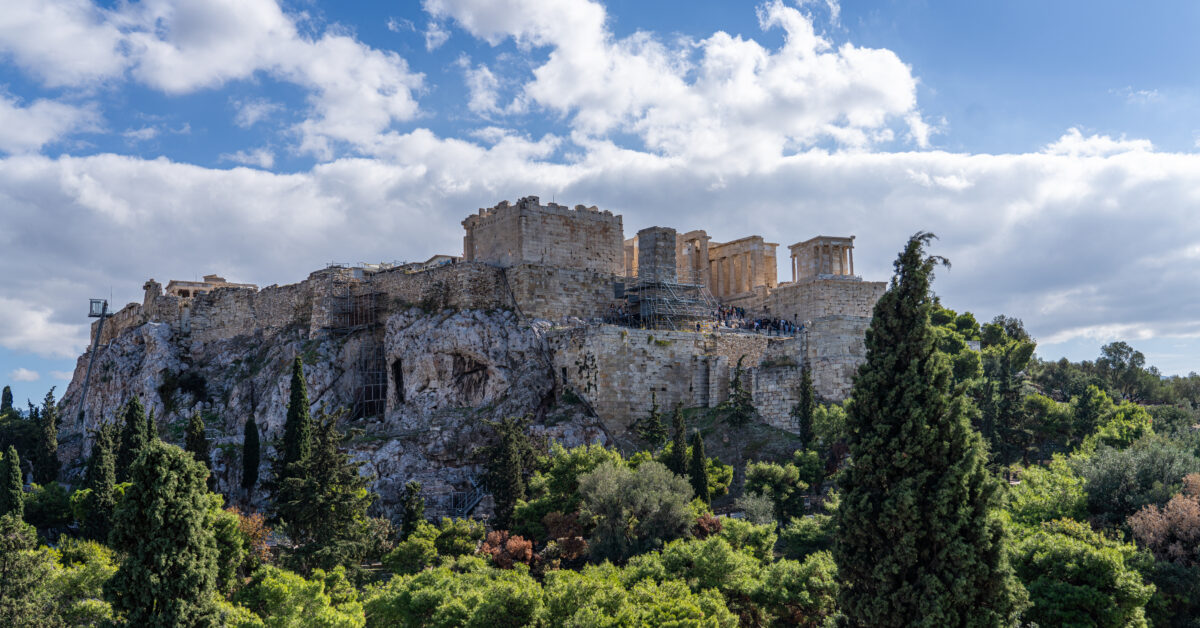
The Acropolis of Athens as seen from Areopagus Hill. While I was there, the Greek gods never wanted to bless me with good light.
The Parthenon
While still part of The Acropolis, the imposing Parthenon is definitely the centerpiece, and as such, deserves special mention. In fact, I learned that a common mistake many people make is believing the Parthenon to be the Acropolis. Just think of it like this, the fortified citadel as a whole is the acropolis, while the building at its heart is the Parthenon.
At the moment, the Parthenon is undergoing a restoration process that began in 2019, so expect it to be covered in scaffolding. This may not be convenient for viewing at the moment, but once it’s complete, it’s going to be incredible!
Access to the Parthenon comes with your ticket to the acropolis.
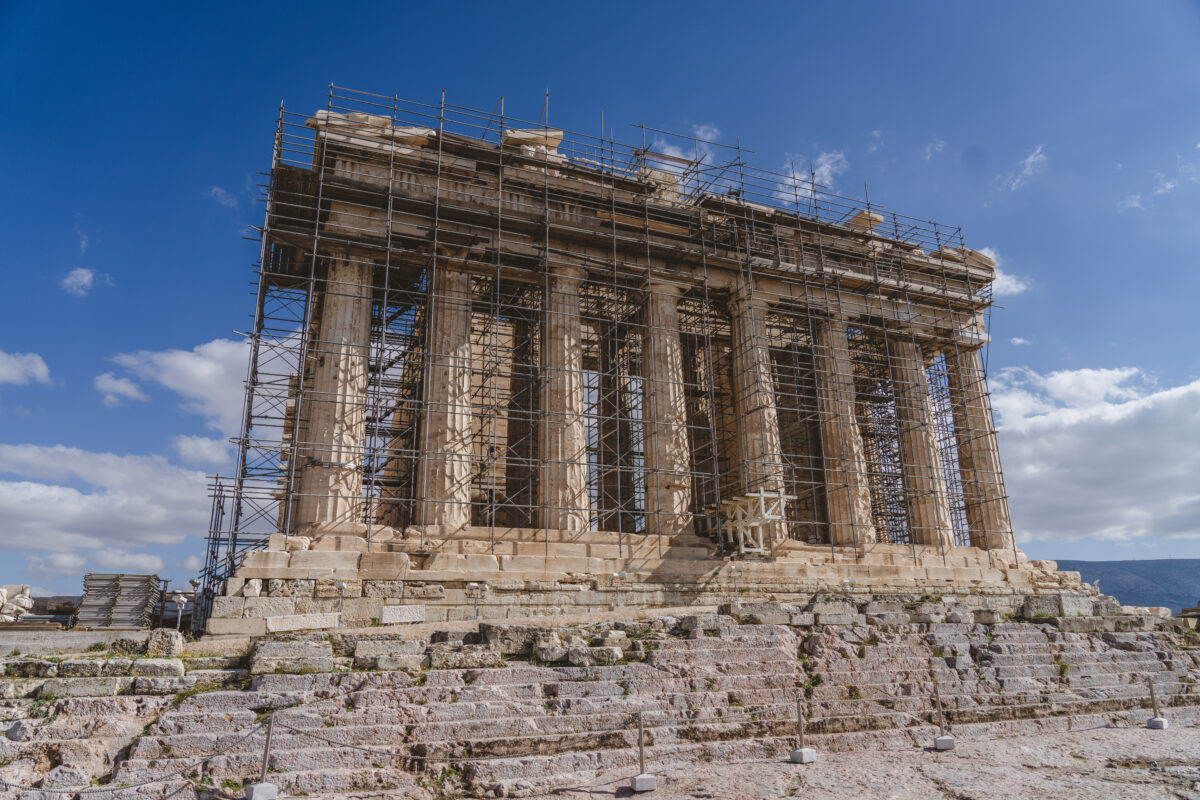
The mighty Parthenon getting a little tender loving care.
Odeon Of Herodes Atticus
Built in AD 161, The Odeon of Herodes Atticus is a stone Roman theatre located on the southwest slope of the Acropolis.
As you’re on your way up the side of the acropolis, this will be one of the first structures you pass. Grand and imposing, it was built, destroyed, and then restored in the 1950s.
It was closed to the public while I was there, but even if it is, you’re still able to stand along the top edge where it will sweep before you. If you’re really lucky, you may be there when a live performance is scheduled to take place. If that happens I would 100% try to get tickets.
I’ve yet to luck out but a low-key goal of mine is to see something live in one of these ancient theaters. Some major names have performed here, and I’d love to see one in person.
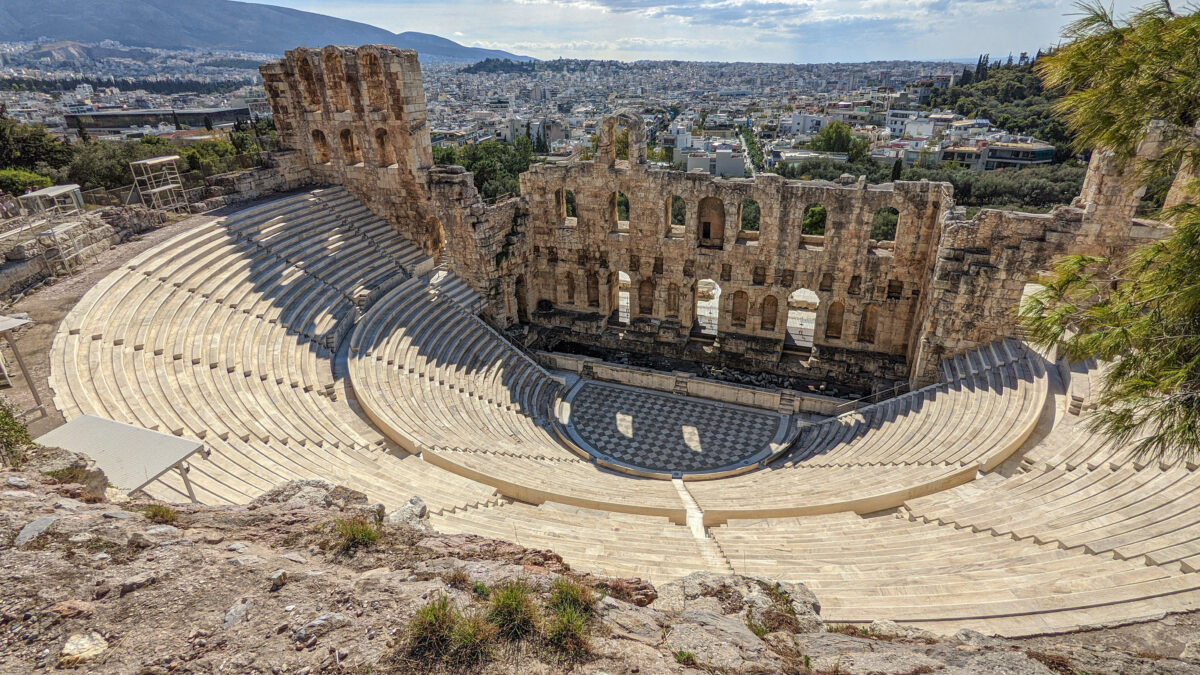
If you want a unique experience and you’re lucky enough to be in Athens while there is a live performance going on, be sure you don’t miss it!
Areopagus Hill
Areopagus Hill, also known as the Hill of Ares, is a prominent rock outcropping located northwest of the Acropolis. You’ll find some minor ruins here but nothing particularly of note. Though, while I was there, a new discovery was being excavated so this may change.
The best reason for visiting the hill is the view. You’ll be treated to a panoramic view of the city and the Acropolis.
I was here at midday, so I can’t really comment on it, but allegedly, the sunrise and sunsets you’ll see from Areopagus Hill are thought to be better than when viewed from the higher up Acropolis.
Just be careful as you climb up and move along the edges as the rock has been polished smooth by thousands of years worth of foot traffic, making it very easy to slip.
Areopagus Hill is open twenty-four hours a day.
The Prison of Socrates
Bill and Ted’s Excellent Adventure is one of my favorite movies, but nonetheless, I will limit my jokes to one as I talk about the prison of Socrates Johnson.
Socrates was a Greek philosopher whose persistent search for ethical knowledge challenged convention. This eventually led to his trial and execution on charges of impiety and corrupting the youth.
This cave complex is believed by many to have been his prison before he was executed. Some refute this claim, but either way, it’s interesting to see an ancient prison cell.
Located in a park, it’s fairly easy to find, even in the dark. You essentially just follow the path from the road uphill. I went here at night and in the dark, expecting there to be lighting at such a historical site. There were none, but I always keep a small flashlight in my bag while traveling so I managed.
Getting back down the hill was a bit more complicated as I thought I could cut straight down. Surprisingly, there were a few steep drop-offs. Luckily I wasn’t running.
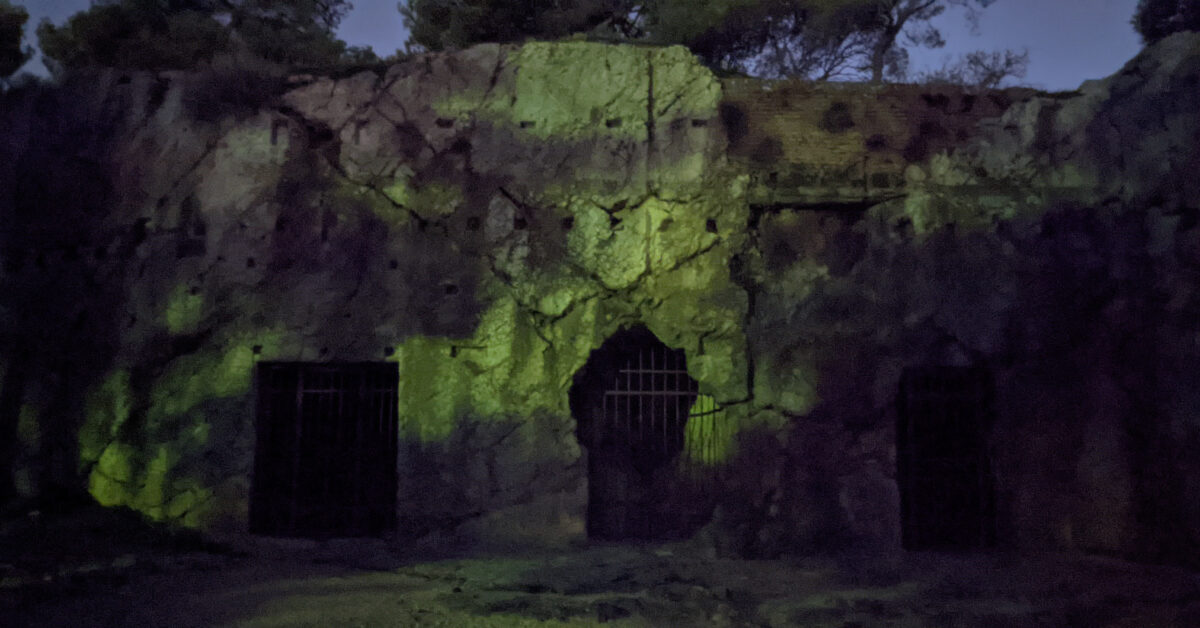
As you can see, the lighting was a bit spotty. It was actually worse than it appears, so try to go during the day!
Philopappou Hill
A small hill, with a small monument dedicated to Gaius Julius Antiochus Epiphanes Philopappos (Imagine having to sign that as your signature every day) at the top.
This hill, which is where you’ll find the prison of Socrates, affords you great views of the city. Pair this with the prison, and you can’t go wrong. Unless you try at night and can’t see where you’re going. *cough*
Acropolis Museum
While The National Archaeological Museum covers Greece as a whole, the Acropolis Museum focuses on, as you may have guessed, The Acropolis of Athens.
The Acropolis Museum was built to house every artifact found on the rock and on the surrounding slopes, dating all the way from the Greek Bronze Age to Roman and Byzantine Greece.
It’s not nearly as large as the National Museum, but there’s still plenty to see.
While it was controversial, the museum is built right on top of ancient Roman ruins that you can walk through. I don’t know how well they did or didn’t do with the preservation, but it looked pretty well done to me
The Acropolis Museum is open Tuesday, Wednesday, Thursday, and Sunday from 8 AM – 8 PM, Friday from 8 AM – 10 PM, and Monday from 8 AM – 4 PM.
Cost:
- 10€ for the adults from April 1 – October 31
- 5€ for adults from November 1 – March 31
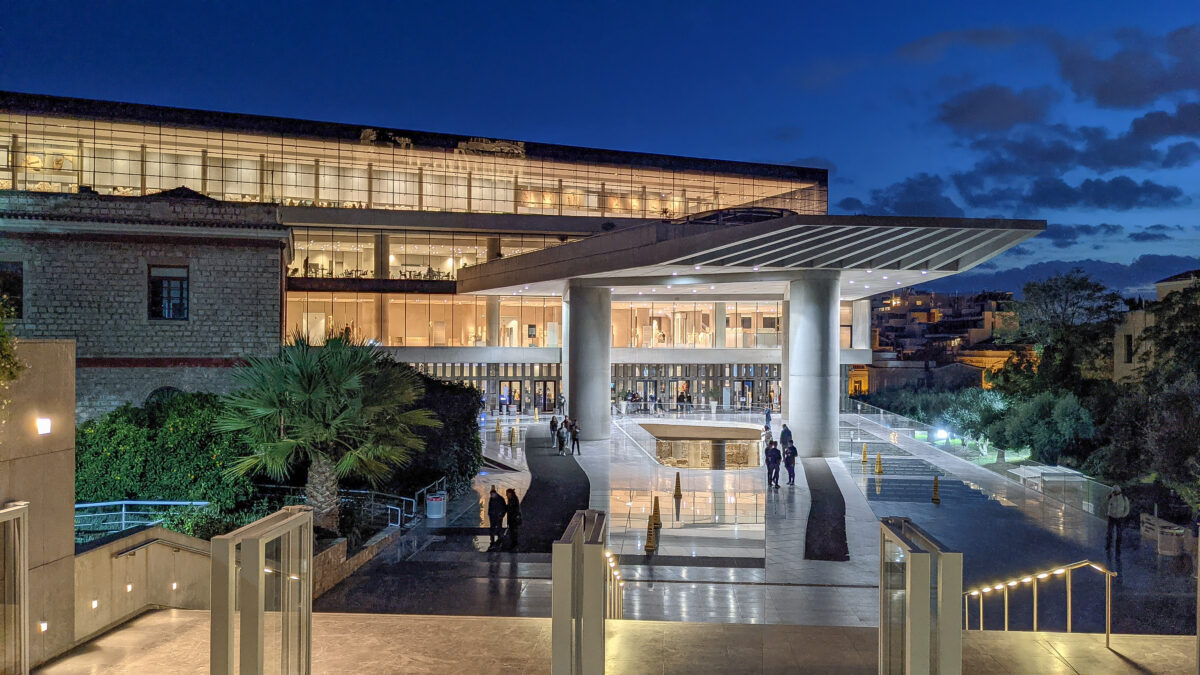
This museum is the perfect size to see everything in about an hour and a half.
Arch of Hadrian
The Arch of Hadrian, or as it’s more commonly known: Hadrian’s Gate, is a monumental gateway resembling a Roman triumphal arch like the ones found in Barcelona or Paris. Hadrian’s Arch spanned an ancient road that led from the center of Athens to the complex of structures on the eastern side of the city which included the Temple of Olympian Zeus.
Is it the biggest ruin? No, not by far. But given its shape and size, it’s still in exceptionally good condition when compared to what it looked like upon completion.
Now, in modern times, the road runs parallel to the arc. It would have been nice if it was set further back, but this does make it readily accessible. I probably passed it at least ten times.
You’ll also find plenty of people selling little souvenirs and trinkets along the road here. These are normally way cheaper than what you find in the shops. Just don’t mention that to the shop-owners while haggling. The two groups don’t particularly get along!
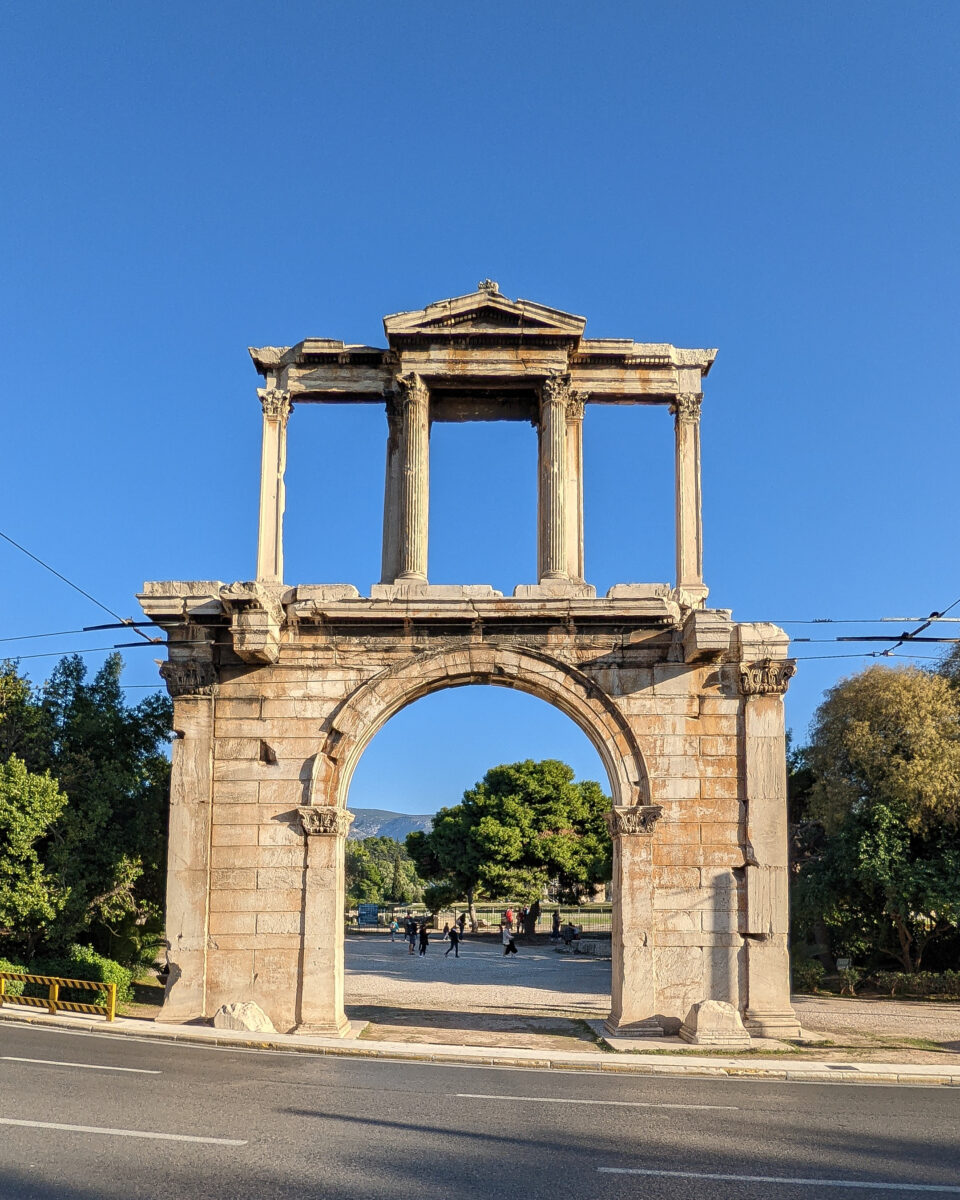
The Temple of Olympian Zeus
The Temple of Olympian Zeus, also known as the Olympieion or Columns of the Olympian Zeus, is a former temple in the center of Athens. As you may have guessed, it was dedicated to the Olympian god Zeus.
While only a small section of it remains standing, what’s still there is colossal, so one can only imagine how big this temple must have been in its full glory.
When I went it was closed off and covered in scaffolding as restorations were underway. If you saw my Instagram stories then you may remember just how badly I wanted to walk up them. /sigh I’m not looking to be like the obnoxious influencer (hate that term) with no regard to the rules though.
The Temple of Olympian Zeus is open from 8 AM – 8 PM from May until September and from 8 AM – 3 PM from October until April.
Cost for The Temple of Olympian Zeus:
- 6€ for the adults from April 01 to October 31
- 3€ for the adults from November 01 to March 31
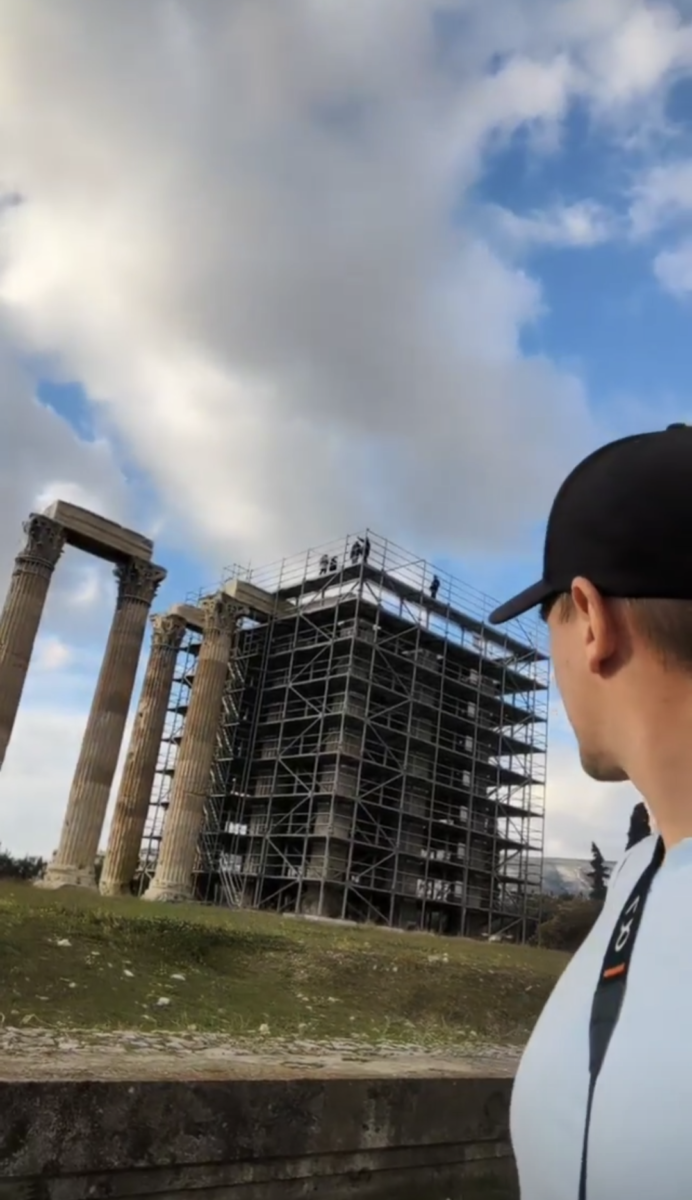
Unfortunately, even though I spent quite a bit of time here, I’ve since realized that I took no pictures of the temple. I did take some video for Instagram though, so here’s a blurry screenshot.
The Changing of the Guard
Changing of the Guard ceremonies take place at the Presidential Mansion and at the Tomb of the Unknown Soldier, which is off Syntagma Square below the Hellenic Parliament building.
This was really cool to see, and hear.
You’ll want to see the Changing the Guard at the Tomb of the Unknown Soldier which has become a popular tourist attraction over the years. These presidential guards, known as Evzones, change every hour, on the hour, in an elaborate, ceremonial march.
Or, if your timing is right, a more impressive ceremony takes place at 11:00 AM on Sundays, where a larger group of guards gather.
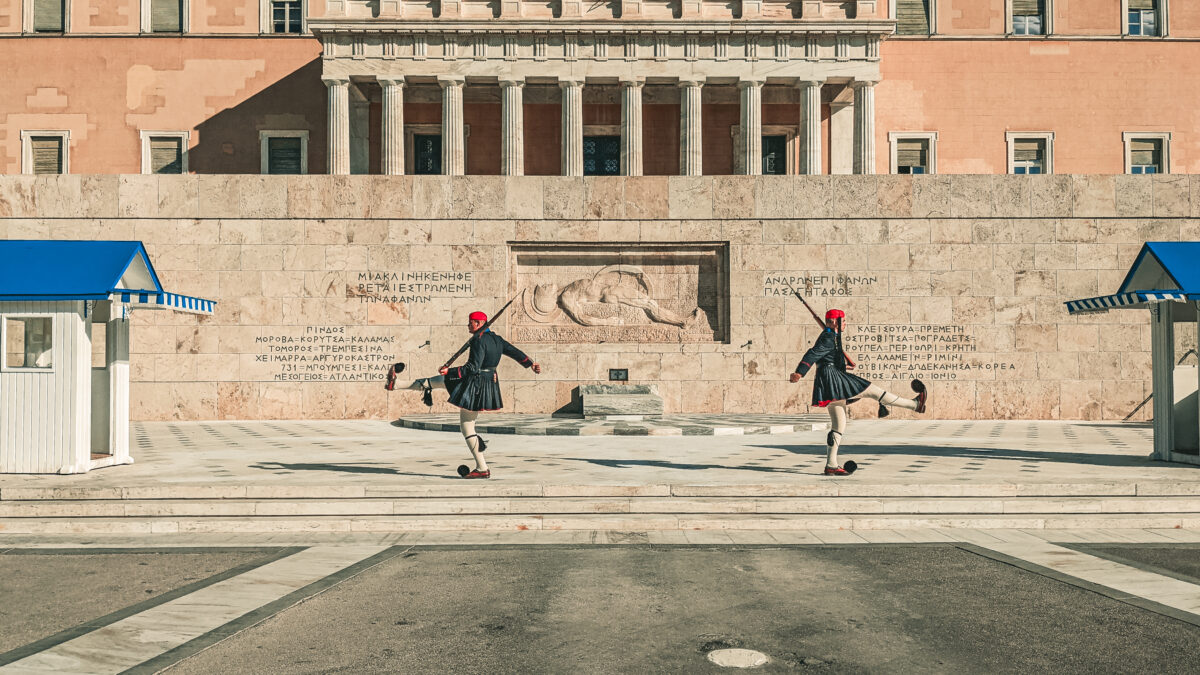
The changing of the guard is an elaborate procession that you shouldn’t miss!
The First Cemetery of Athens
If you’re into the macabre, The First Cemetery of Athens is the official cemetery of the City of Athens and the first to be built. It opened in 1837 and soon became a prestigious cemetery for Greeks and foreigners. If you look around and go deep into it, you’ll find some very old graves.
Or, if you’re into cats, it’s worth a visit just for that. I don’t think I’ve ever seen more in one place; there were hundreds of them. Something I like to do is feed the strays I come across. If there are enough of them, and Athens has a lot, I sometimes get a small bag of something to feed them. Cat food is easiest because while dogs can eat both, the opposite isn’t always true.
Anyway, as soon as the bag came out, I was swarmed. I ended up buying more because there were so many.
And because I know you’re so curious, while I do like both, dogs are my favorite.
The First Cemetery of Athens is open daily from 8 AM – 8 PM. Admission is free.
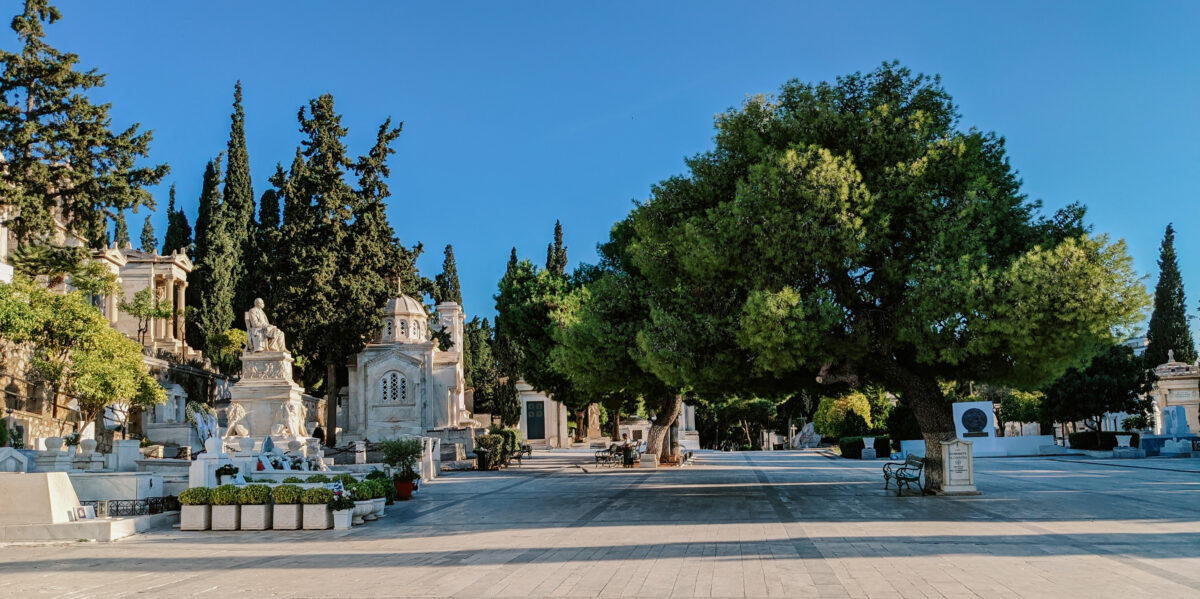
The First Cemetery of Athens. Home to 4,000 cats.
Panathenaic Stadium
Originally built in 300 BC, primarily for the Panathenaic Games, the Panathenaic Stadium has been used, abandoned, rebuilt, and refurbished several times over the centuries.
After being refurbished, it hosted the opening and closing ceremonies of the first modern Olympics in 1896 and was the venue for four of the nine contested sports.
While the original capacity was 50,000, it currently seats 45,000, making it the largest stadium in the world that is built completely of marble. It may not look it, but for comparison, Yankee Stadium currently has a capacity of 54,251.
If you’d like, you’re free to wander the seats, run the track, and stand on the podium.
The Panathenaic Stadium is open daily from 8 AM – 7 PM
Cost: 5 €
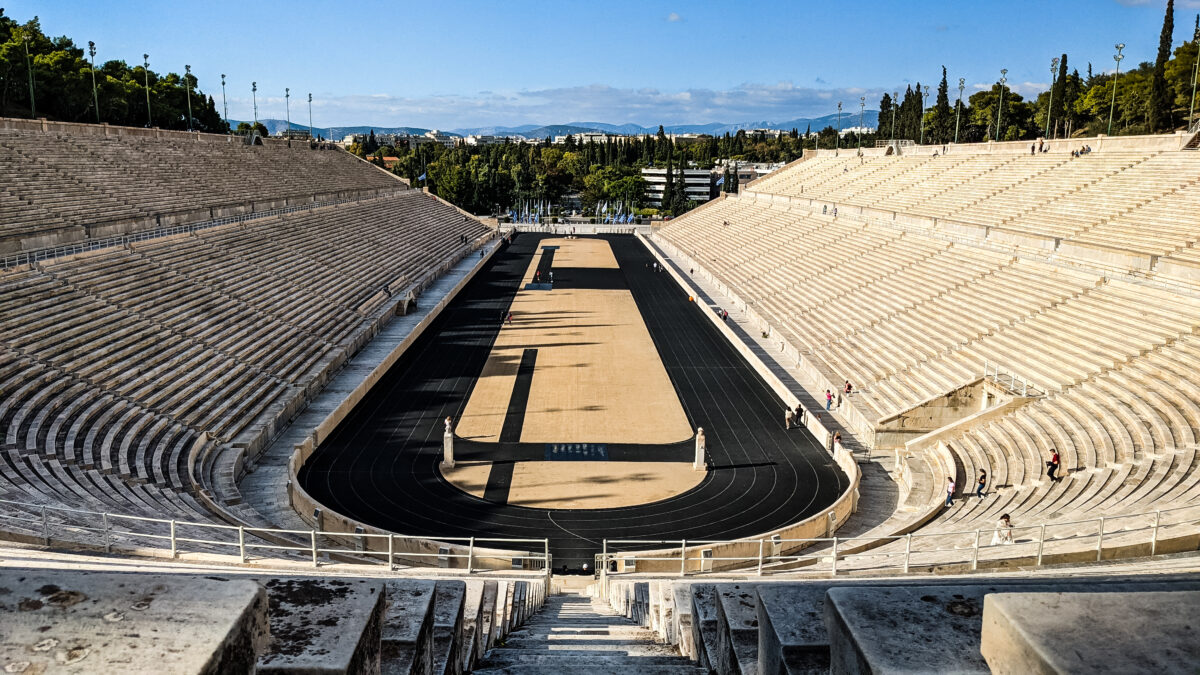
I got a picture of myself on the podium but having finished second in a one man race, I was less impressed with myself than McKayla Maroney. And after all those people showed up to watch me run, too.
Mount Lycabettus
The highest point in central Athens, Mount Lycabettus is a Cretaceous limestone hill believed to have been accidentally dropped by Athena while she was carrying a limestone mountain for the creation of the acropolis.
In addition to great views of the city, you’ll find the 19th-century Chapel of St. George, a theatre, and a restaurant at its two peaks. While you are able to hike to the top, most visitors are too lazy for that and ride the Lycabettus Funicular up.
I, of course, being twice as lazy, did neither and went to a bar instead. Therefore, I can’t comment on the views, but they’re supposed to be great, and my beer was delicious!
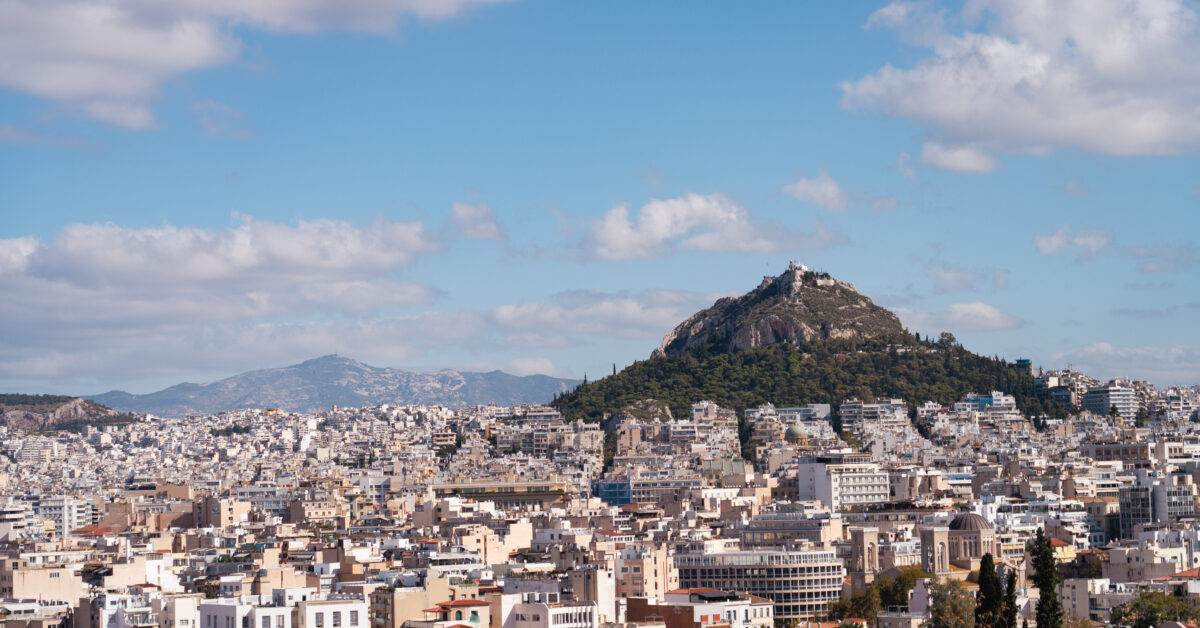
Mount Lycabettus
The National Archaeological Museum
Not all museums are my thing *cough* modern art *cough* but the National Archaeological Museum is right up my alley. I love ancient history, and this was full of it.
As it should, this museum contains the largest collection of Greek antiquity artifacts in the world.
The National Archaeological Museum is open Tuesday – Friday from 9 AM – 8 PM and Saturdays and Sundays from 9 AM – 4 PM.
Cost:
- 12€ for the adults from April 01 to October 31
- 6€ for the adults from November 01 to March 31
The Plaka
The historical Plaka neighborhood is basically the “Old Town” of Athens. Seated beneath the Acropolis, it was built on top of the residential section of ancient Athens. Here you’ll find winding, pedestrian-only cobblestone streets, beautiful colored buildings, and some of the best places to eat or shop in the entire city.
While it wasn’t Greek food, my favorite place to eat was here, and it had a specialty for Italian meatballs. I remember heading down the walkway and seeing around fifteen tables out front. It was freezing cold, yet every table was full and every single person was eating the same thing. Generally, that’s a good sign. I just wish I could remember the name of the place for you. Sorry! Yes, yes… such a tease.
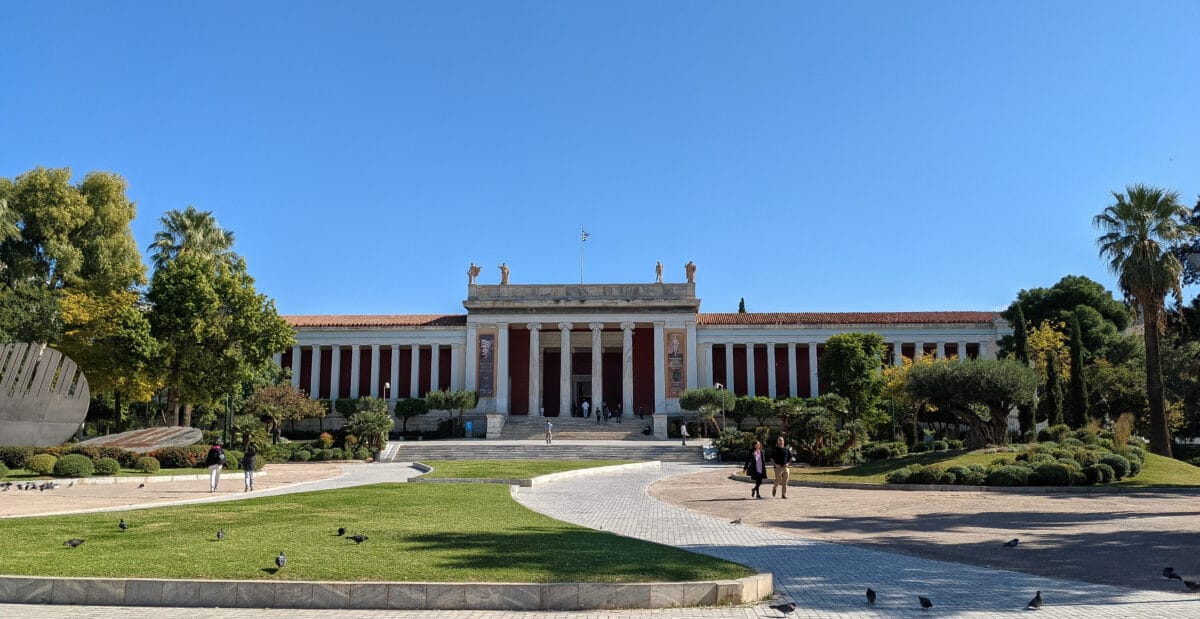
The Roman Agora
Located to the north of the Acropolis and to the east of the Ancient Agora, the Roman Agora was primarily an open market, unlike its predecessor which served as a place of political gatherings for Athenians.
Currently, only a small portion of the columns are still standing. This includes the 12-meter tall Horologion of Andronikos Kyrrhestes, also known as the Tower of the Winds, as well as the remains of the public outhouse.
As it has yet to be fully excavated, more may be revealed in the future.
The Roman Agora is open daily day between 8 AM and 5 PM.
Cost:
- 10€ for the adults from April 01 to October 31
- 5€ for the adults from November 01 to March 31
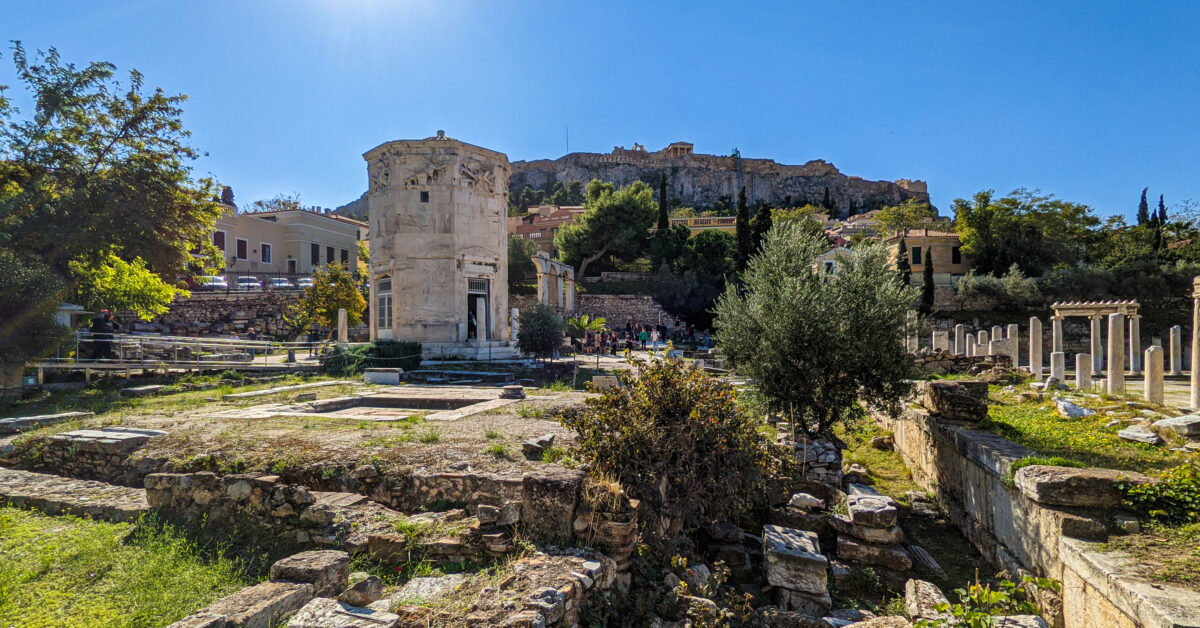
The Ancient Agora and the Temple Of Hephaestus
Located to the northwest of the Acropolis, this is the best-known example of an ancient Greek agora. The Agora’s initial use was for political gatherings and commercial assembly.
Located on the northwest side of the Agora, and on top of the Agoraios Kolonos hill, you’ll find the Temple of Hephaestus. This temple bears special note due to its incredible condition. To date, and thanks to its varied use over the centuries, it remains largely intact, just as it was built.
The Ancient Agora and Agora Museum are open daily from 8 AM – 5 PM.
Cost:
- 10€ for the adults from April 01 to October 31
- 5€ for the adults from November 01 to March 31
Varvakios Central Market
One thing I love seeing while I travel is the local markets, and I missed this one! I’m so disappointed by that fact, but even though I didn’t go, I need to be sure you’re aware of its existence so you can see what I missed.
The Varvakios central market is located on Athinas Street, which connects the Monastiraki neighborhood to Omonia. Here you’ll find all manner of Greek produce, where every possible food under the sun is bought and sold in front of your very eyes.
Ths market is open from 7 AM to 6 PM Monday – Saturday.
Hadrian’s Library
The Library of Hadrian was constructed circa 132-134 CE as part of Roman Emperor Hadrian’s grand plan for the city. The building was used to store important literary works and legal and administrative documents as well as offer a place to hear lectures and host various philosophical schools.
Today, the entrance façade survives with partial restorations. This allows it to give an idea of the scale of the building in its former glory. There is also part of an interior wall where you can see some of the original niches for documents, a bench, and portions of the mosaic flooring from the northeast lecture hall.
Hadrian’s Library is open daily from 8 AM – 3 PM.
Cost:
- 6€ for the adults from April 01 to October 31
- 3€ for the adults from November 01 to March 31
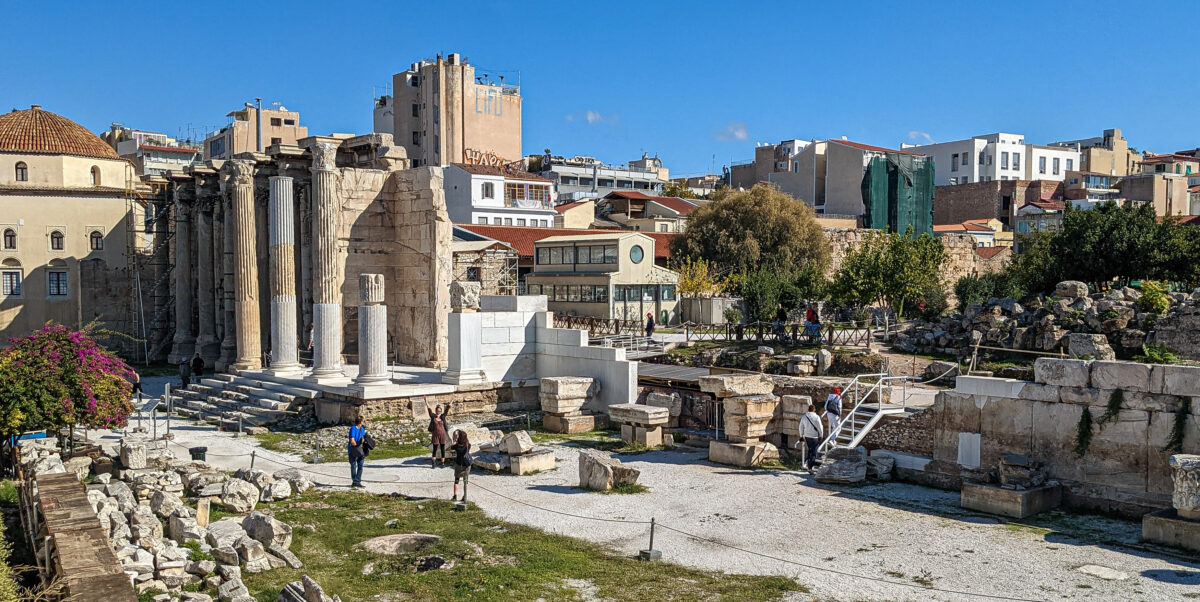
Museum of Cycladic Art
Art museums aren’t my thing, but if they’re for you, you might be interested in checking out the Museum of Cycladic Art.
Founded in 1986 to house Nikolaos and Aikaterini (Dolly) Goulandris’s collection of Cycladic and Ancient Greek art, the Museum has grown into a living cultural institution of international scope and renown. It focuses on the promotion of the ancient civilizations of the Aegean and Cyprus, with particular emphasis on Cycladic art of the 3rd millennium BC.
You’ve got to have collected a lot of art if you’re going to fill your own museum!
If you were wondering, Cycladic art is best known for its small-scale, marble figurines.
The Museum of Cycladic Art is open from 10 AM – 5 PM Wednesday, Friday, Saturday, and Monday. From 10 AM – 8 PM Thursday. From 11 AM – 5 PM on Sunday. And is closed on Tuesday.
Make up your mind already.
Cost:
- 7 € for all but Monday which is only 3.50 €
Monastiraki Square
A 19th-century neighborhood located on the northern side of the Acropolis, Monastiraki Square is the perfect place to find your souvenirs and artisanal goods.
Often billed as a flea market, I didn’t really get that vibe, though supposedly it’s a bit more so on Sundays when the shops close their doors and the tents, stalls, and carpets appear.
As with most markets of this type, you’ll have to do some digging to find the authentic items amidst the sea of cheaper fakes. That is of course if that type of thing concerns you.

Panagia Kapnikarea Church
This is the oldest church in Athens. Located in the center of modern Athens, it’s right in the middle of the Ermou Street shopping area near (in?) Monastiraki.
From the outside, it looks deceptively small, but it expands once you’re in. I highly recommend the few minutes it will take to see the inside of this beauty. For the full experience, be sure to go when it’s light outside because, at night, it’s quite dark inside.
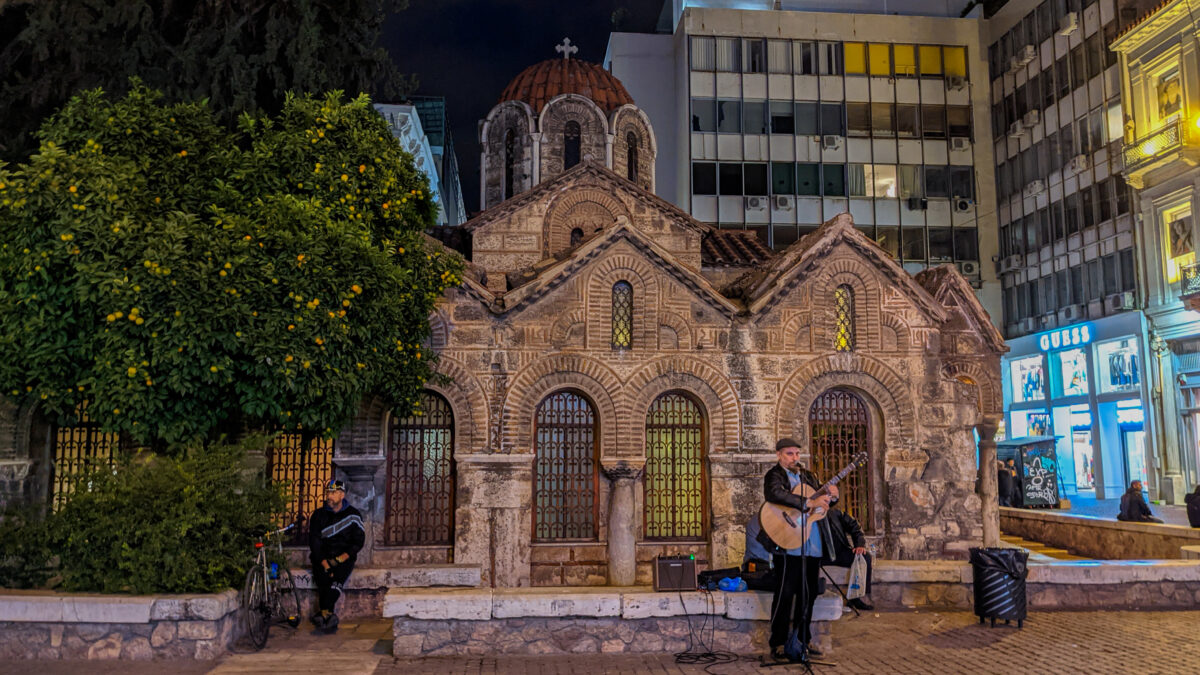
Kerameikos
The potters’ quarter of the ancient city, Kerameikos (Ceramicus – Latinized) is where the English word “ceramic” is derived. It was also the site of an important cemetery and numerous funerary sculptures erected along the Sacred Way.
Keramikos is considered to be one of the more underrated sites around central Athens as it is a little further from the Acropolis than most others, but it’s still worth visiting. Odds are you’ll walk by it at some point.
Kerameikos and its museum are open Tuesday – Sunday: 8 AM – 3 PM. Monday: closed
Cost:
- 8€ for the adults from April 01 to October 31
- 4€ for the adults from November 01 to March 31
Metropolitan Cathedral of Athens
While cathedrals are my second favorite after castles, the Metropolitan Church of the Annunciation to the Virgin Mary just didn’t quite ring my bell.
The inside is absolutely beautiful, way more so than you’d ever expect from seeing the outside. Even though it was built and finished in 1862 from the marble remains of 72 other churches, the facade just looks too new to me.
It is, however, the cathedral church of the Archbishopric of Athens and all Greece, and that alone bears note.
The Metropolitan Cathedral of Athens is open daily from 7 AM – 7 PM. Mass is held at 6:30 AM on Sundays.
Admission is free.
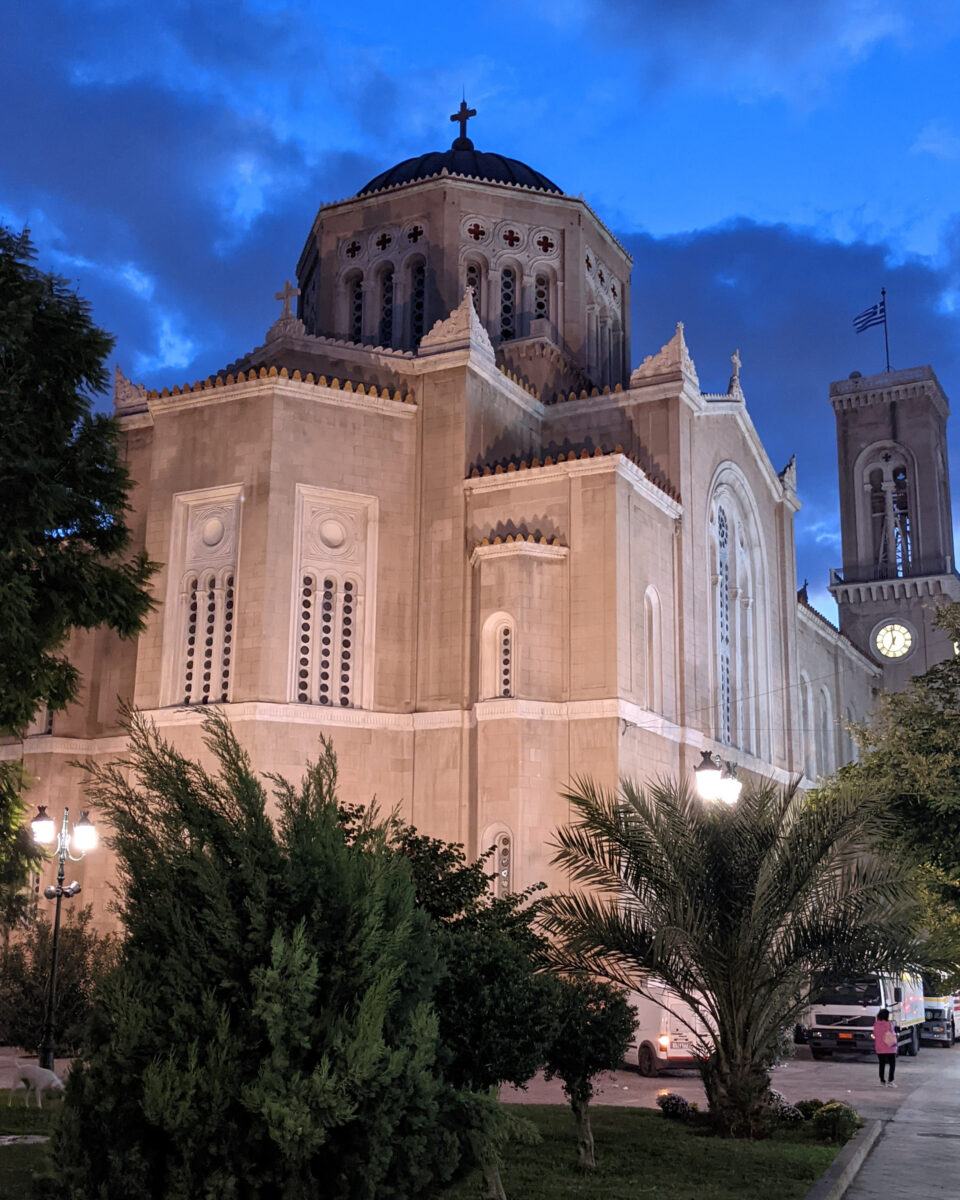
The Psiri Quarter
While this is one of the oldest neighborhoods in Athens, if you’re looking to experience a different, modern side of the city other than everything I mentioned above, you might be interested in seeing the Psiri Quarter (Also spelled Psirri).
A few people at the bar where I was staying recommended going here. I looked into it and passed because it sounded a bit too hipster for me. Have fun though, as it’s filled with unique bars, cafes, and restaurants.
None of these are a reason why most people choose to visit Athens, but still, sometimes a change of pace is a good thing.
Getting Around
As I mentioned above, getting around Athens is incredibly easy to do on foot. I walked everywhere with those two brief exceptions. However, if walking isn’t your idea of a good time, taxis are cheap and readily available. Just be wary of the driver that wants to negotiate a price.
Your best bet is to book a Taxi through Uber so your price will be set, and you won’t have to deal with people trying to jump in it ahead of you. I did have that happen and my driver kicked them out because they weren’t “Pat.”

Lodging
Look, if you want to knock off a list of the best things to do in Athens, then there are good hotels everywhere. You can find something cheap, like I did, or stay somewhere luxurious with a view of the Acropolis.
I personally stayed at Athens Hawks Hostel in a private room. The price was reasonable, it had a good bar (even if it did close too early), an acceptable breakfast, was clean, with a good bathroom, and was located within walking distance of almost everywhere I wanted to go. Just try to limit your search to places near the town center and you’re golden.
Skip the Line and Multi Entrance Tickets
Let me tell you, go on the wrong day, and some of these lines are going to be LONG. While I was there, the lines for the Acropolis and the Acropolis Museum were both a mile long. I made short work of that with a Skip the Line ticket.
It really boggles my mind that more people aren’t aware of them. You simply hop on a site like Tiqets, purchase your ticket, walk right to the gate and show them your digital ticket. They’ll then wave you through while everyone else continues to stand in line for tickets.
Another thing to look into is Combo Tickets. You can buy endless versions of them, but what they’ll do is let you into several sites for a flat price, usually cheaper than buying five different individual tickets.
Or, if you’re feeling ambitious, buy the Athens City Pass. This will give you access to almost all of the available sites, as well as hop-on-hop-off open-top bus access, and a cruise. The only drawback to this is that it’s not Skip the Line. Your call.
What do you think?
Is it somewhere you’d like to go? Or maybe you’ve already been! If so, what is on your list of the best things to do in Athens? Let me know in the comments below!
DID YOU ENJOY THIS ARTICLE? PIN IT!
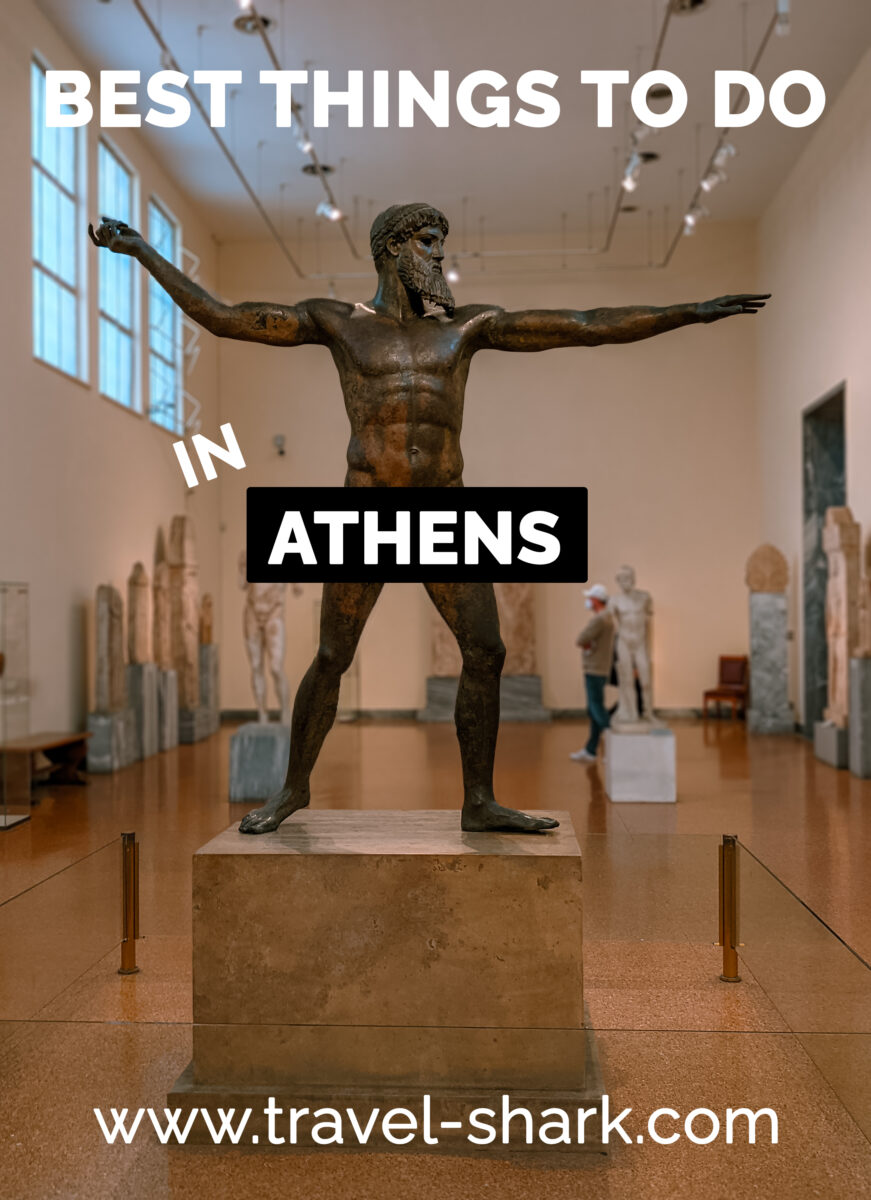

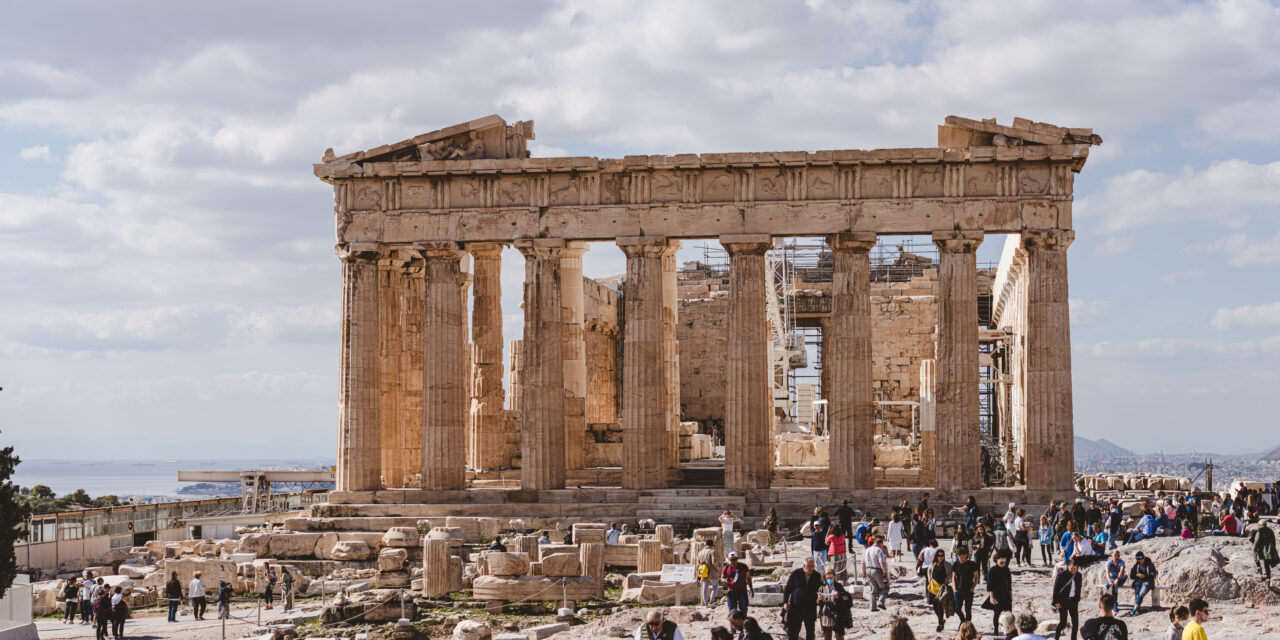





[…] it was all over, there was a nag to my adventures. Sure, something like visiting historic Athens is amazing and fun, I loved it, but it just didn’t have the same sort of mental payoff. There […]
[…] as you can see, Egypt isn’t the most tourist-friendly of destinations. It’s not like Athens where you can stay put and see twenty-five top-level historic sites over the course of four d…. Here, everything is spread out in what I occasionally refer to as tourism […]